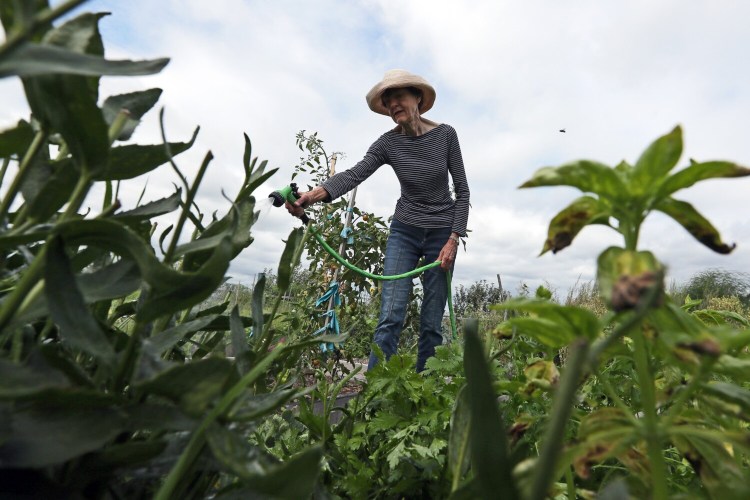Watering a garden – or specific plants in a garden – is simpler than it seems, especially early in the season. My guideline is that too much is better than too little, and too much will be a lot more obvious than too little.
If you have watered too much, the ground will be soggy and, in my own garden, the hiking shoes I wear when gardening will collect a lot of mud. If I forget to take the shoes off, or at least cover them with booties when I go inside, I track mud around the house – which I hear about. So overwatering is obvious. Too little watering requires using a trowel to see if the soil is dry a couple of inches below the surface. Not obvious.
The watering question came to mind in late April and early May when I was griping because it was always too cold, damp or drizzly – there were only a few downpours – to work outside, yet the local TV news ran multiple stories saying that spring, before the woods and fields begin to green up, is a prime time for wildfires. “It would take a major effort in carelessness to start a wildfire today,” I muttered to myself.
Then, a couple of days after a semi-significant rain – about a quarter of an inch – I drove by Maxwell’s strawberry fields here in Cape Elizabeth, and saw that more than an acre of plants was being irrigated. I only saw them from a drive-by distance, but I’m pretty sure these were new plants that won’t provide berries this season.
And that is the key – new plants. Anything you planted in April, which even with climate change is the earliest anyone will want to do any unprotected planting in Maine, should be watered every other day, and every day in some cases, during their first year. If you miss a day because you take a trip, have company or are simply tired, the plant isn’t going to die on you. But if you water every day, the occasional misses won’t be disastrous.
This year so far, we have planted an apple tree, an Aronia (chokeberry) bush, a rhododendron, four more wintergreens (a ground cover) because we liked those we planted last year, some spirea (actually, these were replanted; I moved them to make room for the apple tree), plus vegetables such as lettuce, carrots, beets and onions.
When I’m watering the vegetables in a rush, I water only the onions. The plants need a lot of water to produce large onions that are good for slicing, which is what my wife Nancy wants. Unless we’ve gone a week or more without significant rain, I don’t water the peas or potatoes at all, which we also plant in mid-April.
I also water any shrubs or perennials that we planted the previous summer.
That is the rule for gardening all season long. Most things that grow locally want an inch of rain a week, which makes sense, because Portland’s average annual rainfall is about 49 inches, just a bit below the ideal. But statisticians will remind us that although the average is an inch a week, that doesn’t mean we’ll get an inch every week. Sometimes we get five inches in one week, then no rain for weeks on end – and that is why we need to irrigate.
And remember, just as humans are thirstier in hot weather, so too are plants, which transpire more (give off more water vapor) in the heat, so require more watering.
It is also why everyone who gardens should have a rain gauge. Yes, the local weather forecasters will tell you how much it rained, if you can force yourself to pay attention, but that is rain where they measured, not on your property.
Newly planted shrubs, flowering perennials and vegetables need more than that weekly inch. I wander around with sprinkling cans – adding to my step count – with water from our rain barrels, but most people will probably use hoses, either with sprinklers or just dousing the new plants while holding the hose. I do recommend rain barrels, though, and not just because they allow us to slightly lower our water bill. The water we collect also slows runoff, which sends a wide variety of pollutants to streams, lakes and the ocean.
Although I’ve never read that this is necessary, I also regularly water plants I installed the previous year, if not as often as this year’s plants. I do it when I have free time or my step count is low. (Highly scientific, I know.)
I know it would be easier if the gardening gurus set a rule that if you haven’t had an inch of rain during a week, make up for it. It’s not that simple. All these plants thrived before we had all this science.
Perhaps you’ve planted natives in your garden. You might think, since they were custom-built to grow in Maine conditions, that natives won’t need much watering. But in the wild, just a few of the many seeds of any species would have found just the right spot, sprouted successfully and slowly grown to produce plants. In short, a native seedling will need as much watering as an import.
The simple rules: Water this year’s plants a lot, daily if possible. Water last year’s plants often, but don’t stress. If we’ve gone a couple of weeks with minimal rain, water your whole yard so it gets an inch or more of water.
Tom Atwell is a freelance writer gardening in Cape Elizabeth. He can be contacted at: tomatwell@me.com.
Send questions/comments to the editors.


